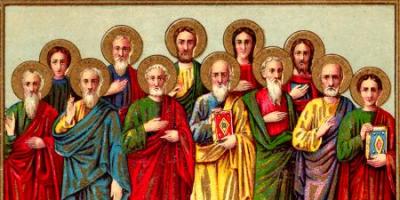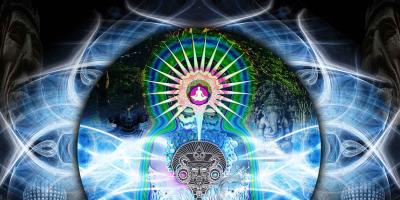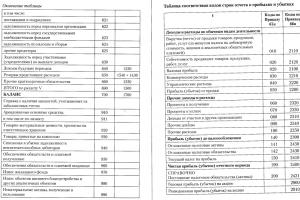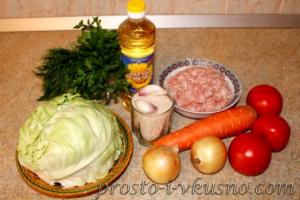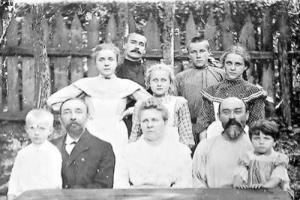On July 13, every year, the Orthodox Church celebrates the feast of the 12 apostles, disciples of Jesus Christ. This is an important day for all Christians. The holy apostles have been honored by the church since the 4th century.
The Council of the 12 Apostles is celebrated the day after the feast day of Paul and Peter, the two supreme saints. Earlier we talked about these two apostles who gave their lives for pure faith and love for God. Peter is one of the 12 main apostles.
12 apostles
Apostol means “servant of God.” These 12 chosen ones include all his closest students. They left their lives and devoted themselves completely to Christ and his mission.
Of course, they too doubted, even they had difficulty understanding the words of Jesus. Many of them were not sure that they were doing everything right, but in the end the truth was revealed to everyone. As you know, one of the chosen apostles even betrayed Christ. All this once again hints at the true human essence - we always doubt and demand proof of the existence of God. For their torment and suffering, they deserved to be present at the Last Judgment, but not next to other people, but next to the Lord.
- Peter. The supreme apostle was crucified upside down in order to look up at God.
- Andrew the First-Called. Brother of the Apostle Peter, who was crucified on a cross in the shape of the letter X. This symbol is the banner of the Russian fleet.
- Matthias. Chosen as an apostle after the betrayal of Judas. He was beaten with stones.
- Simon Zelot. He preached in Abkhazia, for which he was crucified on the cross.
- Thaddeus. Brother of the Lord according to the flesh. He was executed for his faith in Christ in Armenia.
- Matthew. Was burned in Egypt.
- Jacob Alfeev. Matthew's brother. Also died in Africa.
- Thomas, who did not believe in the Resurrection of Christ. Preached in India and Asia. Executed in India.
- Bartholomew. He preached in Asia together with Philip. Executed in Armenia, died in inhuman pain.
- Philip. He carried faith and the cross with Bartholomew. Executed on the cross.
- John the Theologian. Died peacefully in Ephesus. Evangelist, preacher.
- Jacob Zavedeev. Brother of John, killed in Jerusalem.
As you can see, only the Theologian died a natural death. All these people were great martyrs because they accepted terrible torment for their faith in God. Since they were the very first, they were honored to be close to Jesus Christ even after death.
Many churches were built in honor of the 12 apostles, including in Russia. In the 17th century, a church was built in the Kremlin in honor of the most devoted students.
Traditions on July 13
July 13 is also considered a national holiday, because in Russia it has always united people in attempts to become closer to God. On the 13th, it is customary to visit churches and pray for yourself and your family. If you are unable to come to church, read the prayer to the 12 apostles at home:

About the saints, the apostles of Christ: Peter and Andrew, James and John, Philip and Bartholomew, Thomas and Matthew, James and Jude, Simon and Matthew! Hear our prayers and sighs, now offered by our contrite hearts, and help us, the servants of God (names), through your all-powerful intercession before the Lord, to get rid of all evil and enemy flattery, and to firmly preserve the Orthodox faith that you have devoted to us, in which your intercession will not hurt us. , we will not be belittled by reprimand, nor by pestilence, nor by any wrath from our Creator, but we will live a peaceful life here and be honored to see good things on the land of the living, glorifying the Father and the Son and the Holy Spirit, the One in the Trinity, glorified and worshiped God, now and ever and ever forever and ever.
At the Council of the 12 Apostles, it is customary to help not only loved ones or relatives, but also people in general. If someone asks you for help, do not refuse him.
Also on July 13, people ask each other for forgiveness and make peace. This is a great day for all Christians, so that grievances are forgotten.
We wish you good luck and strong faith in God. Of course, this day of the 12 Apostles is not one of the 12 main holidays, but it is no less important for all believers. Be happy and don't forget to press the buttons and
The majestic Patriarchal Chambers in the Moscow Kremlin are among the most significant architectural monuments of the second half of the 17th century. The complex consists of a palace - the residence of the hierarchs of the Russian Orthodox Church, and their home church of the Twelve Apostles. Cathedral Square ends with the Patriarchal Chambers on the north side.
The first head of the Russian church to receive a house on the territory of the Kremlin was Metropolitan Peter during the reign of Ivan Kalita. The building was wooden, like all the others.
The construction of stone buildings for representatives of the highest church hierarchy began in the 15th century by order of Metropolitan Jonah. In 1450, a special metropolitan courtyard was erected not far from the Church of the Deposition of the Robe, but it burned down in a terrible fire in 1493.
The church residence underwent a radical restructuring in the period from 1652 to 1656 under Patriarch Nikon. The most famous architects of that time, recognized masters of stone tent construction - Antip Konstantinov and Bazhen Ogurtsov - took part in the construction. The interior spaces were painted by talented painters for whom the Trinity-Sergius Monastery, Yaroslavl and Kostroma were famous. Tsarist artists were involved in the most complex works - Simon Ushakov, Joseph Vladimirov and Fyodor Kozlov. Unfortunately, we will not see their work, since the painting has not been preserved.

The beauty and splendor of the decoration of the newly rebuilt three-story patriarchal courtyard was not inferior to the interiors of the royal chambers. And its interior contained a real treasury - a rich patriarchal sacristy. Nikon was soon reminded of his excessive luxury; he found himself in disgrace and at trial was accused of pride and the desire to place himself above the sovereign himself.
In 1681, under Patriarch Joachim, a new Cathedral of the Twelve Apostles was built. It began to serve as a house church for the hierarchs, replacing the Deposition of the Robe Church, which had functioned for more than two centuries.
During the reign of Peter I, the patriarchate was abolished. The church properties of the Moscow Kremlin remained ownerless and began to fall into disrepair. In 1718, the Tsar visited the Patriarchal Palace and decided to use the top floor of the premises for a library with rare handwritten and printed books.
In the 19th century, the Church of the Twelve Apostles was once again reconstructed. The work was carried out under the guidance of architect Dmitry Chichagov. They removed the ceiling between floors, refreshed the painting, changed decorative elements, and decorated the church with a new large iconostasis. The temple became brighter, thanks to wider window openings. The Patriarchal Palace was also used; it housed the Synod.

In the rebellious year of 1917, the Patriarchal Palace was badly damaged during the fighting. The church and the wall of the refectory were destroyed by artillery shells. A year later, all Kremlin buildings were nationalized; they became commandant's offices, warehouses and restoration workshops. The Patriarchal Chambers opened to visitors only in 1961 after restoration.

The three-story Patriarchal Palace seemed huge in the old days. Now his building gives the main architectural ensemble of Cathedral Square a complete look. During the time of Nikon, a harmonious complex with a single style was created from disparate buildings.
In appearance, the Patriarchal Palace resembles earlier Kremlin buildings. For example, the outlines of the drums on the Church of the Twelve Apostles almost repeat similar architectural elements on the Archangel Cathedral, and the decoration of the southern facade of the building is the same as on the much older Assumption Church.
The façade and interior of the palace were rebuilt many times, so many architectural inconsistencies can be seen in its appearance. However, this does not spoil the overall impression. In the chambers, Old Russian buildings of various types have been preserved - both ceremonial rooms and small residential halls.

On the second floor there is a unique museum exhibition, which presents decorative and applied arts and life of the 17th century.
The personal belongings of Patriarch Nikon along with his church vestments are displayed in the Grand Entrance. The Cross Chamber houses ancient dishes that were used at ceremonial receptions, hunting equipment of Ivan the Terrible himself and a unique collection of watches.
The exposition of the Order Chambers includes a perfectly preserved set of chess and writing instruments, which were used by the father of Peter I, Emperor Alexei Mikhailovich. Also of interest is the primer of the famous writer and printer Karion Istomin, from which the son of Peter the Great, Tsarevich Alexei, learned to read. In the Prikaz Chambers, a 17th-century living room with original items was recreated - tables, chairs, benches, chests and an elegant tiled stove.
In the Refectory Chamber there is an exhibition displaying ancient facial and ornamental embroidery. Most of the exhibits are items of church utensils - from gold-embroidered covers on thrones to shrouds and curtains on the royal doors. The Cathedral of the Twelve Apostles houses a collection of rare signed icons of the 17th century created by Russian artists, including the famous masters of that time - Fyodor Zubov and Simon Ushakov. Restoration never stops in the Patriarchal Chambers. For example, in 2013, wall paintings from the 17th century were cleared from the front entrance hall and the Executive Chambers.

It is noteworthy that all the objects in the Patriarchal Palace and Cathedral are genuine, they were once in tsarist, boyar or patriarchal use. From them you can imagine the life of the medieval capital, its everyday life and holidays, feeling the spirit of an entire era. Visitors to this unique museum can see in all its colors a turning point in Russian history – the 17th century.
The Patriarchal Palace and the Church of the Twelve Apostles are open to the public every day from 10.00 to 17.00, except Thursdays.
Since the 14th century, since Moscow became the spiritual center of Rus', to the north-west of the Assumption Cathedral there has been a courtyard of the Moscow metropolitans, and since 1589, after the election of Bishop Job to the patriarchal throne, the patriarchs. There were residential and outbuildings, administrative chambers that managed the economy, three churches: the Robe - to the west of the Assumption Cathedral, the Solovetsky Wonderworkers - to the east of the residential chambers and the Three Saints of Moscow Peter, Alexy and Jonah "in the patriarchal vestibule".
 As usual, all the buildings of the yard burned more than once in fires, were destroyed by the enemy, fell into disrepair and were often rebuilt and renewed. Each new owner of the courtyard tried to redo something according to his own taste, so that in general the abode of the rulers looked like a collection of buildings of different sizes and different periods, connected by many internal and external galleries, staircases, winding passages and porches.
As usual, all the buildings of the yard burned more than once in fires, were destroyed by the enemy, fell into disrepair and were often rebuilt and renewed. Each new owner of the courtyard tried to redo something according to his own taste, so that in general the abode of the rulers looked like a collection of buildings of different sizes and different periods, connected by many internal and external galleries, staircases, winding passages and porches.
In the mid-17th century, after Tsar Alexei Mikhailovich, bypassing the lot, appointed his favorite Novgorod Metropolitan Nikon as Patriarch of Moscow and All Rus', the territory of the patriarchal court underwent particularly intensive restructuring.
As contemporary Archdeacon Pavel of Aleppo wrote, “you should know that the current Patriarch Nikon has a great love for the construction of buildings, monuments and splendor... The local patriarchal house has existed since very ancient times, since the time of St. Peter, the first Metropolitan of Moscow. It is small, cramped and has no yard... The current patriarch, loving to build and renovate, asked the king for a yard located near the patriarchal house... and began to erect a huge wonderful building on it... This building amazes the mind with surprise, so maybe Perhaps there is no one like it in the royal palace, for the craftsmen of the present century, the most skilled, gathered from everywhere, built it continuously for three years.”
From 1652 to 1655, three-story residential quarters, a ceremonial Cross Chamber and a new church were built on the site of the dismantled Church of the Solovetsky Wonderworkers in the old Patriarchal Courtyard and the adjacent former Godunov Courtyard. Then, for about three more years, the buildings were intensively finished (famous masters from Yaroslavl, Kostroma, the Trinity-Sergius Monastery, headed by I. Vladimirov and S. Ushakov were invited to paint the temple), but Nikon’s quarrel with the tsar in the summer of 1657, the patriarch’s departure to Novy Jerusalem and its eight-year fall from grace “froze” construction. In 1666 Nikon was deprived of his patriarchal rank. Work on the chambers and the new church was completed only under Patriarch Joachim. In 1680-1681 The church lost the gallery on the south side and the staircase leading to the Assumption Cathedral (since then the door portal of the temple hung above the void), but on the north side it acquired an open gallery-porch, decorated with flies and polychrome tiles. In 1681, the church was consecrated in the name of the Twelve Apostles.
It was a pillarless, five-domed temple with restrained decoration for its time. Three chapters were illuminated, two were decorative; underneath them were closed choirs that connected the church space with the living quarters of the patriarch, located on the third floor of the chambers. Neither the paintings nor the iconostasis have survived to this day. The one that stands in the temple now comes from the Ascension Cathedral of the Kremlin monastery of the same name and dates back to the 1680s. Once upon a time, the iconostasis of the church was crowned with a large “Crucifix with those present” - believed to be the first time in the history of an Orthodox church. Then this tradition was established everywhere.
In 1703, Peter the Great abolished the patriarchate, and a few years later the Patriarchal Chambers housed the Synodal House, in which, until moving to St. Petersburg in 1731, meetings of the Holy Synod, the new collegial governing body of the Church, took place. On the third floor, in the living quarters of the patriarch, the famous Patriarchal sacristy was located.
In 1763, the dilapidated Church of the Three Saints was dismantled and a furnace for preparing church peace, an aromatic oil used in various rituals, was moved from it to the Cross Chamber of the Synodal House. Since then, the chamber has often been called the Peace Chamber.
In the 19th century The Church of the Twelve Apostles was re-painted with oil paints and a new iconostasis was installed. Throughout the 19th and early 20th centuries, it was one of the few Kremlin churches where services were held daily.
Since 1918, repair and restoration work was carried out in the Patriarchal Chambers and the Church of the Twelve Apostles, as a result of which an iconostasis from the Ascension Monastery appeared in it, and in the altar there was a carved altar canopy, which previously stood in the Cathedral of St. Michael the Archangel of the Kremlin Miracle Monastery.
 Currently, the building of the Patriarchal Chambers houses the Museum of Applied Arts and Life of Russia. The permanent exhibition, telling about Russian culture and life of the 17th century, includes about 1000 exhibits. In two halls of the palace, where the original interior was completely recreated, antique tables, armchairs, chests and caskets, table clocks, chess, handwritten books, first textbooks, precious dishes, and jewelry are on display. Here you can find works by both Russian and foreign masters.
Currently, the building of the Patriarchal Chambers houses the Museum of Applied Arts and Life of Russia. The permanent exhibition, telling about Russian culture and life of the 17th century, includes about 1000 exhibits. In two halls of the palace, where the original interior was completely recreated, antique tables, armchairs, chests and caskets, table clocks, chess, handwritten books, first textbooks, precious dishes, and jewelry are on display. Here you can find works by both Russian and foreign masters.
In the church premises there is an exhibition of icons from the 17th century, most of which came from Kremlin workshops or decorated Kremlin cathedrals. The exhibition provides an opportunity to follow the development of icon painting of the 17th century, which is divided into two stages:
- The first stage (1600-1650s) is represented by icons that embodied the desire to revive the fading spirit of the former great art by following the ancient artistic canon (the line of development of the art of the “Grozny school”) and its increased aestheticization (the line of art of the “Stroganov school”);
- The second stage (from the 60s to the end of the century) is represented by icons that embodied the desire to gradually move away from the traditional style of Old Russian painting towards realistic art.
The exhibition features icons of famous royal isographers of the late 17th century: the icon “Fedor Stratilates” by Simon Ushakov, the icon “St. Andrew the First-Called” by Fyodor Zubov, the icon “The Crucifixion with the Apostolic Passion” by Fyodor Rozhnov and others.
On the northern shore of the Kinneret, in a monotonous beach-palm landscape, the pink domes of the Greek Orthodox Church of the 12 Apostles clearly stand out from afar.
Greek Church of the Cathedral of the Twelve Apostles. Built in the 1980s on part of the territory of the evangelical Capernaum. Made in the tradition of the churches of island Greece. Consisting of cubes and domes in the form of hemispheres. However, unlike Greece proper, where domes are always painted blue, here they turned out to be red. This turned the small church into a bright color dominant of the panorama. The territory of the monastery is interesting not for the archological excavations, but for the atmosphere of a patriarchal estate reigning here with a half-deserted, but rich southern garden with chickens, geese, peacocks and incredibly kind dogs. This entire vast farm is maintained by a single monk, Brother Irinarchus from Greek Macedonia. The gates of the hospitable monastery are almost always open.

Is it a coincidence that Jesus chose twelve apostles? Undoubtedly, He saw in them a kind of ancestors of the New Testament Community, just as ancient Israel traced its descent from the twelve patriarchs. Christ speaks of thrones on which His twelve disciples will sit to “judge,” that is, to lead. It is significant that after the betrayal of Judas, the apostles considered it necessary to choose another in his place in order to maintain the number of twelve.

Here the Lord loved to retire, here his sermons were heard, miracles happened here: the healing of the weakened, the healing of the mother-in-law of the Apostle Peter.
Monasteries and temples began to be built on the banks of the Kinneret in the places where Jesus lived and preached in the 4th century. In the first half of the 13th century, during an earthquake, Capernaum, which was prosperous at that time and had a large Christian community, was completely destroyed.
At the end of the 19th century, the Greek Patriarchate bought a plot of land on the ruins of Capernaum to build a monastery.
The Temple of the 12 Apostles was built at the beginning of the 20th century, in 1920. Since then, with short interruptions, the temple has been active. 
..
There is a quiet and cozy corner here, as if intended for solitude and prayer. There is a small pier or a summer refectory with access to the Kinneret. Everywhere Christian symbolism - fish 
..
Water source 
Pilgrims from all over the world visit this place.
A particularly noticeable renovation began in the 90s. The temple was renovated and painted by the Greek artist Constantine Dzoumakis. 
In general, the painting of the church is amazing and captivating
Fresco "Judgment" Where is heaven and where is hell I think everyone understands 
The dome is decorated with icons of the apostles 
Unusual icon of Jesus with the soul of his dead mother in his arms 
Lapels and chandeliers are strikingly gilded 
..
Icons made in various styles 
..
In general, look for yourself how solemnly beautiful everything is 
..
..
..
..
..
..
..
Coupled with a beautiful courtyard where peacocks live, magnificent flowers bloom and there are various figurines and other decorations, the atmosphere here glows with kindness and tranquility 
And for comparison, the next picture was taken in 2007 and immediately after it as it was before 

